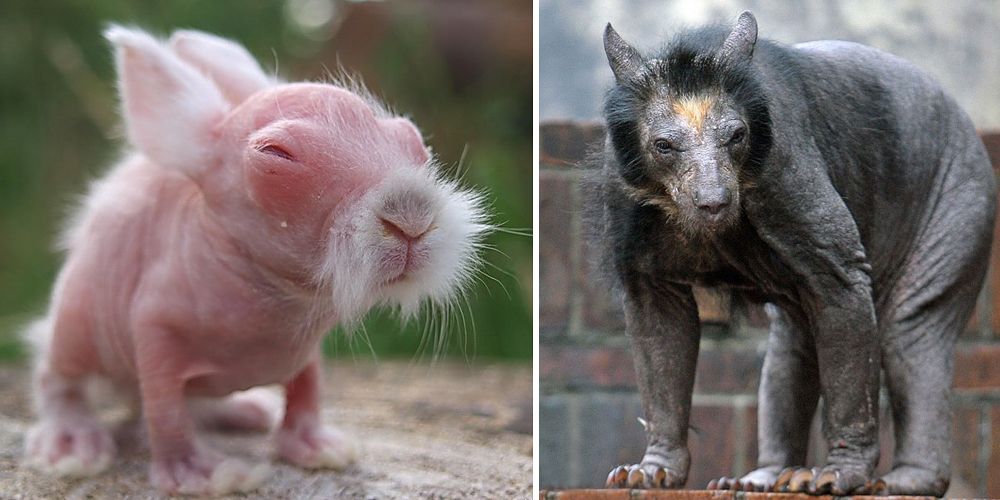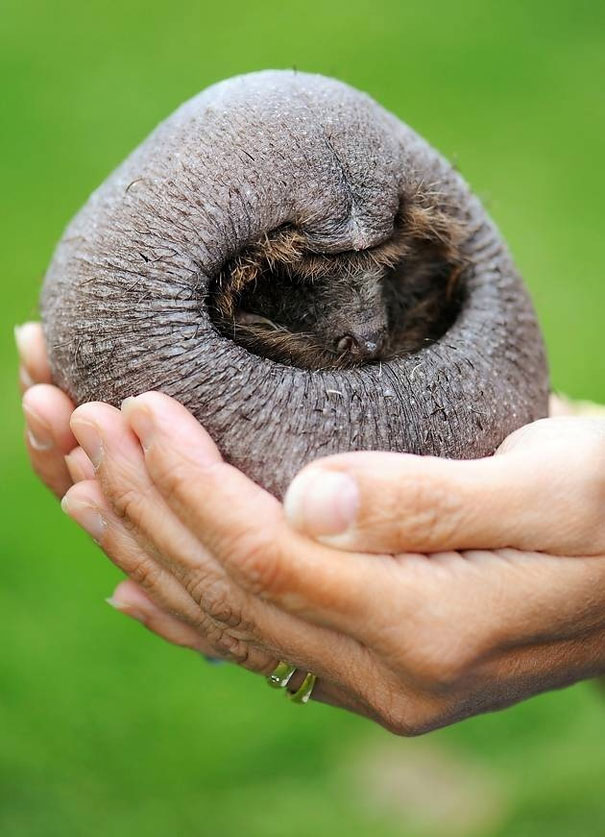Hey there, animal enthusiasts! Today we're diving deep into a topic that might make you scratch your head—or maybe even scratch yourself if you're feeling itchy. **Animal with no hair** is not just a quirky phrase; it’s a fascinating look into the world of creatures that have adapted in some seriously unexpected ways. You might be picturing naked mole rats or hairless cats, but trust me, this journey goes way beyond that. Let’s explore why some animals decided to go bold and completely bare.
So, why are we talking about animals with no hair? Well, it’s not just because they’re weirdly cute or oddly fascinating—though they totally are. Hair, or the lack thereof, plays a crucial role in survival, adaptation, and evolution. These critters teach us a lot about how nature works in mysterious ways. And hey, who doesn’t love learning something new, right?
Before we dive into the nitty-gritty, let’s set the scene. Imagine a world where animals don’t rely on fur or hair to keep them warm, cool, or protected. Instead, they’ve evolved other strategies to thrive in their environments. That’s exactly what we’ll uncover in this article. So, buckle up and get ready to meet some of the most unique creatures on the planet!
Read also:Coby Ryan Mclaughlin Wiki The Rising Star You Need To Know About
What Makes an Animal "No Hair"?
When we talk about animals with no hair, we’re not just talking about bald patches or a bad hair day. These critters are naturally hairless, and their lack of fur is often a result of evolution. Hair serves many purposes in the animal kingdom, from insulation to camouflage. But for some animals, going without hair has its own set of advantages.
For instance, some animals live in environments where hair would actually hinder their survival. Think about aquatic animals like dolphins or sharks. Hair would just create drag in the water, making it harder for them to swim efficiently. Other animals, like the naked mole rat, live underground where temperature regulation isn’t as much of a concern. In these cases, evolution has favored a hairless lifestyle.
Evolutionary Advantages of Being Hairless
Now, let’s talk about the perks of being bald in the animal world. Believe it or not, there are quite a few advantages to going fur-free. Here’s a quick rundown:
- Temperature Regulation: Hairless animals often have better control over their body temperature. They can cool down faster or warm up more efficiently depending on their environment.
- Reduced Parasites: Without hair, there’s less hiding space for parasites like fleas or ticks. That’s a big win for animals living in crowded colonies or humid environments.
- Aquatic Adaptation: As we mentioned earlier, animals that spend a lot of time in water benefit from being smooth and sleek. Hair would just slow them down.
- Camouflage: In some cases, a hairless appearance helps animals blend into their surroundings better than fur would.
So, you see, being hairless isn’t just a random mutation. It’s a carefully crafted adaptation that gives these animals a leg up in the survival game.
The Most Famous Hairless Animals
Let’s meet some of the stars of the hairless animal world. These critters have gained fame—not just for their looks but for their incredible survival skills. From the quirky to the downright bizarre, here are a few of our favorites:
1. Naked Mole Rat
First up, we have the darling of the hairless animal kingdom: the naked mole rat. These little guys might look like they’re auditioning for a horror movie, but don’t let their appearance fool you. Naked mole rats are practically superheroes in the animal world.
Read also:Ruthie From The Real World The Untold Story Of A Reality Tv Icon
They can live up to 30 years—way longer than most rodents—and they’re nearly immune to cancer. Plus, they can survive without oxygen for up to 18 minutes. Talk about tough cookies! Naked mole rats live in underground colonies where hair would just get in the way, so evolution said, “Nah, let’s skip the fur this time.”
2. Hairless Cats
Next, we have the feline divas of the hairless world: the sphynx cats. Now, don’t get me wrong, these cats aren’t completely hairless—they’ve got a fine layer of peach fuzz, but it’s so minimal that they look like they just stepped out of a waxing salon.
Despite their lack of fur, sphynx cats are incredibly affectionate and social. They’re also known for being super clean, as they need regular baths to keep their skin healthy. These cats are a testament to the fact that beauty comes in all forms—even the hairless ones.
3. Aquatic Giants: Dolphins and Sharks
When it comes to aquatic animals, hair is more of a hindrance than a help. Dolphins and sharks have evolved smooth, streamlined bodies that allow them to glide effortlessly through the water. Imagine trying to swim with a furry coat—that’d be like wearing a wool sweater in the pool. Not ideal.
Instead, these animals rely on blubber or specialized skin structures to stay warm and protected. It’s a brilliant adaptation that helps them thrive in their watery worlds.
The Science Behind Hairlessness
So, how exactly does an animal become hairless? Is it a random mutation, or is there more to it? The answer lies in genetics and evolution. Hairlessness can occur due to a variety of factors, including:
Genetic Mutations
In some cases, hairlessness is caused by a genetic mutation. For example, the sphynx cat’s lack of fur is the result of a recessive gene. This means that both parents must carry the gene for their offspring to be hairless. While this mutation might seem like a disadvantage, it’s actually what makes sphynx cats so unique and desirable.
Natural Selection
In other cases, hairlessness is a result of natural selection. Animals that live in environments where hair isn’t necessary—or even detrimental—may gradually lose their fur over time. This process can take thousands—or even millions—of years. It’s nature’s way of saying, “Hey, you don’t need that anymore.”
Behavioral Adaptations in Hairless Animals
Being hairless isn’t just about looking cool; it also affects how animals behave. These critters have developed some pretty interesting habits to cope with their lack of fur. Let’s take a look at a few examples:
Temperature Regulation
Hairless animals often have to work harder to regulate their body temperature. Naked mole rats, for instance, live in underground burrows where the temperature is relatively stable. This means they don’t need fur to stay warm or cool. On the other hand, hairless cats rely on external heat sources, like basking in the sun or snuggling up to their owners, to stay cozy.
Social Behavior
Interestingly, many hairless animals are highly social. Naked mole rats live in large colonies with a strict social hierarchy, while sphynx cats are known for their affectionate and attention-seeking behavior. It’s possible that their lack of fur has influenced their social interactions, making them more reliant on physical contact and communication.
The Role of Hairlessness in Conservation
Now, let’s talk about the bigger picture. Hairless animals play an important role in conservation efforts. By studying these creatures, scientists can learn more about how animals adapt to changing environments. This knowledge can then be applied to conservation strategies for other species.
For example, understanding how naked mole rats resist cancer could lead to breakthroughs in cancer research. Similarly, studying the smooth skin of dolphins and sharks could inspire new technologies for reducing drag in transportation or improving swimming efficiency in humans.
Common Misconceptions About Hairless Animals
There are a lot of myths and misconceptions surrounding hairless animals. Let’s bust a few of them:
- Myth #1: Hairless Animals Are Always Cold – Not true! Many hairless animals have evolved other ways to stay warm, such as blubber or specialized skin structures.
- Myth #2: Hairless Animals Are More Prone to Disease – While it’s true that some hairless animals may require extra care, they’re not inherently more susceptible to illness than their furry counterparts.
- Myth #3: Hairless Animals Are Less Attractive – Beauty is subjective, folks! Many people find hairless animals incredibly cute and endearing.
So, the next time someone tries to tell you that hairless animals are weird or ugly, you can set them straight with these facts.
How You Can Help Hairless Animals
If you’re passionate about animals with no hair, there are plenty of ways you can get involved. Here are a few ideas:
- Support conservation organizations that study and protect hairless animals.
- Adopt a hairless pet, like a sphynx cat, and give them a loving home.
- Spread awareness about the unique adaptations and importance of hairless animals.
Every little bit helps, and by supporting these incredible creatures, you’re contributing to a better future for all animals.
Conclusion: Celebrating the Bold and the Bald
And there you have it, folks—a deep dive into the world of animals with no hair. From the quirky naked mole rat to the sleek and streamlined dolphin, these critters remind us that diversity is the spice of life. Their unique adaptations and survival strategies teach us so much about the wonders of nature.
So, the next time you see a hairless animal, don’t just think of them as weird or odd. Think of them as pioneers—creatures that have embraced their differences and thrived because of it. And remember, if you’ve learned something new today, why not share this article with your friends? Or better yet, leave a comment and let us know what you think. Together, we can celebrate the beauty of all animals—whether they’re covered in fur or completely bald.
Thanks for joining me on this journey, and until next time, keep exploring the wild and wonderful world of animals!
Table of Contents
- What Makes an Animal "No Hair"?
- The Most Famous Hairless Animals
- The Science Behind Hairlessness
- Behavioral Adaptations in Hairless Animals
- The Role of Hairlessness in Conservation
- Common Misconceptions About Hairless Animals
- How You Can Help Hairless Animals
- Conclusion: Celebrating the Bold and the Bald


